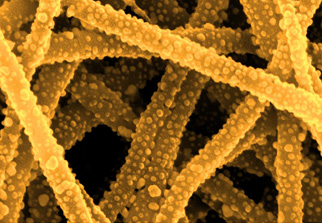Hinestroza receives federal grants to create fabrics to render toxic chemicals harmless
By Sheri Hall

Cornell fiber scientist Juan Hinestroza is working with the U.S. government to create fabrics made of functional nanofibers that would decompose toxic industrial chemicals into harmless byproducts.
Potential applications include safety gear for U.S. soldiers and filtration systems for buildings and vehicles.
Hinestroza, assistant professor of fiber science in the College of Human Ecology, is a member of two teams that secured more than $2.2 million from the U.S. Department of Defense; about $875,000 will go directly to Hinestoza's work. Both grants are multi-university collaborative efforts funded through the U.S. Defense Threat Reduction Agency.
"These nanostructures could be used in creating advanced air filtration and personal protection systems against airborne chemical threats and can find many applications in buildings, airplanes as well as personal respirators," Hinestroza said.
The first project, in collaboration with North Carolina State University, is aimed at understanding how very small electrical charges present in fibers and nanofibers can help in capturing nanoparticles, bacteria and viruses.
"Understanding how these charges are injected into the fibers and how they are dissipated under different environmental conditions can open an avenue to significant improvements in air filtration technology," Hinestroza said.
The position and distribution of the electrical charges on the nanofibers will be fed into computerized fluid dynamics algorithms developed by Andrey Kutznetsov of NC State to predict the trajectory of the nanoparticles challenging the filter. Hinestroza and NC State's Warren Jasper pioneered work in this area a couple of years ago.
The second project, in collaboration with the University of California-Los Angeles (UCLA), will study the incorporation of a new type of molecules -- called metal organic polyhedra and metal organic frameworks -- onto polymeric nanofibers to trap dangerous gases as toxic industrial chemicals and chemical warfare agents, then decompose them into substances that are less harmful to humans and capture them for further decontamination. The synthesis of these molecules was pioneered by Omar Yaghi of UCLA.
This project will also look into the potential toxicity of these nanofiber-nanoparticle systems to humans in collaboration with Andre Nel from UCLA Medical School.
Hinestroza's research group specializes in understanding and manipulating nanoscale phenomena in fiber and polymer science.
Sheri Hall is assistant communications director for the College of Human Ecology.
Media Contact
Get Cornell news delivered right to your inbox.
Subscribe